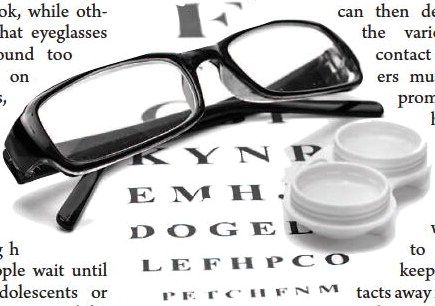How to help kids adjust to contact lenses


Adults find contact lenses more convenient than traditional eyeglasses for a variety of reasons. Some adults don't like the way eyeglasses look, while others find that eyeglasses move around too much on their faces, requir ing nearconstant ad- justment. T h o u g h many people wait until they're adolescents or even full-grown adults to even consider contact lenses, these popular alternatives to eyeglasses can be worn by children as well.
The United States Food and Drug Administration notes that children can safely wear contact lenses. In fact, the FDA even notes that young athletes may find contacts are better for sports than eyeglasses because they don't break, potentially reducing the risk of eye injuries that can occur if eyeglasses break during competition. But con- tacts don't just benet athletes. According to the FDA, in certain instances, contact lenses improve the quality of vision in comparison to eyeglasses, especially for children who are very nearsighted.
Some adults are hesitant to try contact lenses out of fear of in- juring their eyes when putting them in. Others may be wary of potential infection with lenses they place directly on their eyes. Parents can expect children to have similar reservations, and there are some strategies moms and dads can try to help their children ad- just to wearing contact lenses.
Point out the popularity of contact lenses. Children may be hesitant to wear contact lenses because they don't see other people wearing them every day.
But they actually do. According to the Centers for Disease Control and Prevention, more than 45 million Americans wear contact lenses. Explain to children that many of the people they see every day, including teachers, coaches, police officers, etc., are likely wearing contact lenses.
Kids who recognize just how many people safely wear contacts each day may be more willing to give them a try. If kids remain hesitant and doctors haven't specifically recommend they wear contacts, give them more time to come around.
Demonstrate safe handling. If adults are concerned about potential eye infections, kids may have those same reservations. To help kids adjust and over – come any fears they may have, parents can point out that safe handling greatly reduces the risk of eye infection from contact lenses. Parents can then demonstrate the various steps contact lens wearers must take to promote safe handling.
Washing hands with soap and water prior to handling, keeping contacts away from water and properly cleaning them with a disinfecting solution are a few tech- niques to safely handle contact lenses. Parents and their children can discuss other safe han- dling techniques with their eye doctors at length.
Encourage chil dren to carry their eyeglasses with them at all times. Instruct kids to take their eyeglasses with them everywhere just in case they lose a contact lens during the day or if the lenses grow uncomfortable.
Eyeglasses and a contact kit with disinfecting solution inside can fit easily into children's backpacks, and knowing an alternative is always on hand can ease any comfort concerns kids may have throughout the day.
Children can safely wear contact lenses, though parents should be prepared to help them adjust as they gradually grow acclimated to this convenient alternative to eyeglasses.








